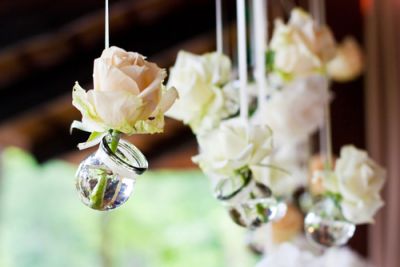 Since the dawn of time, humans have analyzed various aspects of the natural world and coded them into powerful symbols. It’s unsurprising that cultures all over the world have concocted complex collections of connotations, assigning different meanings to blooms growing in wild, urban, pastoral, and cultivated habitats. If you’d like to have even more fun with your wedding flowers and send a subtle message, here are some things that you’ll need to know.
Since the dawn of time, humans have analyzed various aspects of the natural world and coded them into powerful symbols. It’s unsurprising that cultures all over the world have concocted complex collections of connotations, assigning different meanings to blooms growing in wild, urban, pastoral, and cultivated habitats. If you’d like to have even more fun with your wedding flowers and send a subtle message, here are some things that you’ll need to know.
Floriography Throughout History
Written evidence of floriography dates as far back as the third century BCE. The Hebrew Tanakh contains several references to flowers and plants with symbolic meaning. For example, Song of Songs includes multiple analogies in which the speakers use Middle Eastern flora to describe each other and their burgeoning love. Town and Country writer Katie Robinson discusses common meanings of the lotus flower in an April 2017 article, noting that it can symbolize enlightenment, rebirth, or purity in many East and South Asian cultures. More references exist in William Shakespeare’s play “Hamlet,” when Ophelia refers to violets standing for humility, innocence, chastity, and faithfulness.
Modern couples may also be familiar with the Victorian era practice of floriography. Martha Stewart Weddings writer Lyndsey Matthews mentions an 1819 text called “Le Langage des Fleurs,” penned by French author Louise Cortambert writing under the pseudonym Charlotte de Latour. Although there are other floriography guides that predate Cortambert’s book, hers was published shortly before the Victorian age.
Flowers and Their Meanings
Victorian cultural norms dictated that romantic notions should not be expressed openly, so couples began sending each other coded messages with floral arrangements. Today’s sources can give multiple and sometimes conflicting interpretations for some plants and blooms. Nevertheless, a few examples of popular flowers and their associated meanings include:
- Baby’s breath for innocence or everlasting love
- Calla lilies, which stand for magnificent beauty
- Chrysanthemums, meaning either wealth, truth, or friendship
- Dahlias, dignified blooms that represent a lasting commitment
- Gardenias, which can mean purity or refinement
- Lavender, usually standing for love or devotion
This isn’t an exhaustive list of flowers and their respective messages, but you may find Matthews’ Martha Stewart Weddings piece and The Knot’s guide to wedding floral symbolism useful in your planning.
Floriography in Your Wedding
One way to take your wedding look to the next level is to select your flowers based on their associated messages. Your choices will involve both looking at the bigger picture with your décor and deciding how to fashion individual bouquets, corsages, centerpieces, and boutonnieres. Your event’s color palette can also guide your decisions, but don’t forget that opting for seasonally available blooms can keep your costs down. The Knot’s guide breaks down what’s usually in season during each time of the year, but your florist can also offer great suggestions.
A discerning attendee may be able to pick out the messages your wedding flowers are sending, but not all your guests may understand these deeper meanings. If you decide to let the cat out of the bag, you can include a short guide to these in the back of your wedding program. Creative ideas for your reception can include decorating each table using one of your chosen flowers as its key element, both in colors and the primary blooms used in its centerpiece. You could even name each table for a flower in your schema, but be mindful that this could confuse attendees who are used to assigned table numbers.
Your Wedding Flowers’ Messages
If you’re inspired by floriography, you can use it to design a stunning look that also sends subtle messages. Your flowers can express your love for each other, your gratefulness to your guests, or a little of both. Balancing creativity with practicality is the key to fashioning your special day.
Add Your Comment